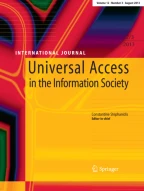Abstract
Future Internet (FI) technologies are introducing new ways of networking and cognitive data delivery. In this paper, the potential of FI-based architectures for enabling the context-aware content adaptation and specialized delivery of health related information in assistive environments is investigated. The proposed system utilizes the publish/subscribe internetworking (PSI) architecture, an information-oriented architecture built for the FI using the so-called publish/subscribe paradigm. Information is brought at the center of the approach, providing several advantages: flexibility, seamless information morphing and exploitation of context, access control, and security in general. In addition to an overview of the approach and its characteristics, this work also presents the implementation of a subset of an assistive environment, using Blackadder, PSI’s prototype, and illustrates its potential with an emergency service scenario for the assistive healthcare domain.
Similar content being viewed by others
Notes
Each function call requires additional parameters—such as payload size—which are omitted for clarity.
It should be noted here that other general-purpose scopes can be created for other events. Moreover, different types of emergency events can have their own scopes.
For clarity, payloads have been omitted.
References
Trossen, D., Pavel, D., Guild, K., Bacon, J., Singh, J.: Information-centric pervasive healthcare platforms. In: Proceedings 4th International Conference on Pervasive Computing Technologies for Healthcare (Pervasive Health) (2010)
Khedo, K.K.: Context-aware systems for mobile and ubiquitous networks. In: Proceedings International Conference on Networking, International Conference on Systems and International Conference on Mobile Communications and Learning Technologies (ICN/ICONS/MCL) (2006)
Doukas, C., Maglogiannis, I., Kormentzas, G.: Advanced telemedicine services through context-aware medical networks. In: Proceedings International IEEE EMBS Special Topic Conference on Information Technology Applications in Biomedicin (2006)
Maglogiannis, I.: Introducing intelligence in electronic healthcare systems: state of the art and future trends lecture notes in computer science (including subseries Lecture Notes in Artificial Intelligence and Lecture Notes in Bioinformatics), 5640 LNAI, pp. 71–90 (2009)
Doukas, C., Maglogiannis, I., Karpouzis, K.: Context-aware medical content adaptation through semantic representation and rules evaluation Proceedings—3rd International Workshop on Semantic Media Adaptation and Personalization, SMAP 2008, art. no. 4724861, pp. 128–134 (2008)
Fox, J., Beveridge, M., Glasspool, D.: Understanding intelligent agents: analysis and synthesis. AI Commun. 16(3), 139–152 (2003). IOS Press
Zhai, J.H., Zhang, S.F., Wang, X.Z.: An overview of pattern classification methodologies. In: Proceedings of the Fifth International Conference on Machine Learning and Cybernetics 3222–3227 (2006)
Doukas, C., Maglogiannis, I.: An assistive environment for improving human safety utilizing advanced sound and motion data classification. Univers. Access Inf. Soc. 10, 217–228 (2011)
Witten, I.H., Frank, E.: Data mining: practical machine learning tools and techniques, 2nd edn. Morgan Kaufmann, San Francisco (2005)
Feldmann, A.: Internet clean-slate design: what and why? ACM SIGCOMM Comput. Commun. Rev. 37(3), 59–64 (2007)
Jacobson, V., Mosko, M., Smetters, D., Garcia-Luna-Aceves, J.J.: Content-centric networking. Whitepaper. Palo Alto Research Center, Palo Alto (2007)
Jacobson, V., Smetters, D.K., Thornton, J.D., Plass, M.F., Briggs, N.H., Braynard, R.L.: Networking named content. In: Proceedings of ACM CoNEXT, (2009)
SAIL Project: D-3.1 (D-B.1) The network of information: architecture and application. (2011) http://www.sail-project.eu/wp-content/uploads/2011/08/SAIL_DB1_v1_0_final-Public.pdf
Trossen, D., Parisis, G.: Designing and realizing an information-centric internet. IEEE Commun. Mag. 50(7):60–67, (2012), special issue on ‘Information-Centric Networking’
Koponen, T., Chawla, M., Chun, B., Ermolinskiy, A., Kim, K.H., Shenker, S., Stoica, I.: A data-oriented (and beyond) network architecture. ACM SIGCOMM Comput. Commun. Rev. 37(4), 181–192 (2007)
Caesar, M., Condie, T., Kannan, J., Lakshminarayanan, K., Stoica, I.: ROFL: routing on flat labels. ACM SIGCOMM Comput. Commun. Rev. 36(4), 363–374 (2006)
Eugster, P.T., Felber, P., Guerraoui, R., Kermarrec, A.M.: The many faces of publish/subscribe. ACM Comput. Surv. 23(2), 114–131 (2003)
Xylomenos, G., Vasilakos, X., Tsilopoulos, C., Siris, V.A., Polyzos, G.C.: Caching and mobility support in a publish-subscribe internet architecture. IEEE Commun. Mag. 50(7):52–58, (2012), special issue on ‘Information-Centric Networking’
Katsaros, K., Xylomenos, G., Polyzos, G.C.: MultiCache: an overlay architecture for information-centric networking. Comput. Netw. 55(4):936–947 (2011) Elsevier, special issue on ‘Architectures and Protocols for the Future Internet’
Tarkoma, S., (ed.) PSIRP deliverable 2.3, architecture definition, component descriptions, and requirements. (2010) http://www.psirp.org/
Fotiou, N., Trossen, D., Polyzos, G.C.: Illustrating a publish-subscribe internet architecture. Telecommun. Syst. 51(4):233–245, (2012), Springer, Special Issue on ‘Future Internet Services and Architectures: Trends and Visions’
Jokela, P., Zahemszky, A., Rothenberg, C.E., Arianfar, S., Nikander, P.: LIPSIN: line speed publish/subscribe inter-networking. ACM SIGCOMM Comput. Commun. Rev. 39(4), 195–206 (2009)
Nikander, P., Marias, G.F.: Understanding pure publish/subscribe cryptographic protocols. In: Proceedings of the Sixteenth International Workshop on Security Protocols. Cambridge, England (2008)
Kjällman, J., (ed.): PURSUIT deliverable 3.2, first lifecycle prototype implementation (d3.2). (2011) http://www.fp7-pursuit.eu
Lagutin, D., Tarkoma, S.: Cryptographic signatures on the network layer-an alternative to the ISP data retention. In: Proceedings of IEEE Symposium on Computers and Communications, Riccione, Italy (2010)
Author information
Authors and Affiliations
Corresponding author
Rights and permissions
About this article
Cite this article
Doukas, C., Fotiou, N., Polyzos, G.C. et al. Cognitive and context-aware assistive environments using future internet technologies. Univ Access Inf Soc 13, 59–72 (2014). https://doi.org/10.1007/s10209-013-0299-y
Published:
Issue Date:
DOI: https://doi.org/10.1007/s10209-013-0299-y
